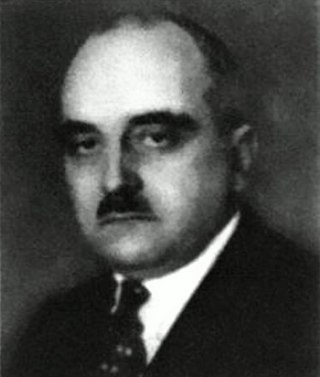Related Research Articles

Wilhelm Guddorf was a Belgian journalist, anti-Nazi and resistance fighter against the Third Reich. Guddorf was a leading member of a Berlin anti-fascist resistance group that was later called the Red Orchestra by the Abwehr. Guddorf was the editor of the Communist Die Rote Fahne newspaper.

Rudolf "Rudi" Jahn, was a German politician and Minister-President of Brandenburg (1949–1952).

Gustav Ernst Hans Jendretzky was a German Communist politician. He was a prominent politician of the Socialist Unity Party (SED) in the German Democratic Republic.

Werner Scholem was a member of the German Reichstag from 1924 to 1928 and a leading member of the Communist Party of Germany. Scholem and his wife, Emmy, were portrayed in the 2014 documentary "Between Utopia and Counter Revolution".
Friedrich Wilhelm Beuttel was a German communist and resistance fighter against Nazism.
Hermann Weber was a German historian and political scientist. He has been described as "the man who knew everything about the German Democratic Republic".

Leo Drabent was a German peace campaigner and Communist activist.

Franz Dahlem was a German politician. Dahlem was a leading official of the Communist Party of Germany (KPD) and, after 1945, of East Germany's ruling Socialist Unity Party (SED).

Eduard Ludwig Alexander was a German politician of the Communist Party (KPD) and a representative in the Reichstag.
Elisabeth "Else" Zaisser was a German teacher who became secretary of state and then Minister for People's Education in the East Germany.

Wilhelm Knöchel was a German Communist Party activist and organizer who after 1933, became an anti-government resistance activist. His trial lasted ten minutes. He was executed/murdered at the Brandenburg-Görden penitentiary, a short distance outside Berlin, to the west of the city.
Rudolf (Rudi) Schwarz was a German Communist Party activist who after 1933 became an anti-government activist. He was arrested, detained and then, a few weeks short of his thirtieth birthday, handed over to the Gestapo who shot him at the beginning of February 1934.
Elly Lotte Bergtel-Schleif, née Schleif, was a German librarian who was actively involved in the resistance against Nazis while a member of the Communist Party of Germany (KPD). Bergtel-Schleif became head of the Berlin Library School after the war.

Adolf Rembte was a German communist and resistance fighter against the Nazi régime.

Walter Husemann was a German communist and resistance fighter against the Nazi regime. As a young man, Husemann trained an industrial toolmaker, before training as a journalist. He became interested in politics and joined the Communist Party of Germany (KPD). With the arrival of the Nazis in 1933, he became a resistance fighter and through his wife, the actor Marta Husemann, he became associated with an anti-fascist resistance group around Harro Schulze-Boysen and Arvid Harnack that was later called the Red Orchestra by the Gestapo. Along with John Sieg whom he met in the KPD and Fritz Lange, Martin Weise and Herbert Grasse he wrote and published the resistance magazine, The Internal Front Die Innere Front.

People of the Saefkow-Jacob-Bästlein Organisation is a list of participants, associates and helpers of the Saefkow-Jacob-Bästlein Organization, which was one of the largest anti-Nazi resistance organisations that came into existence during World War II in Germany. It was formed in Berlin and had contacts to many other regions that hosted industrial manufacturing. It is therefore also referred to in the literature as the operational leadership of the Communist Party of Germany (KPD). However, it was not only communists among the groups of the Saefkov Jacob Bästlein organisation. The 506 known persons included about 200 before 1933 to the KPD, 22 to the Social Democratic Party of Germany (SPD) or to the Socialist Workers' Party of Germany (SAP) and around 200 were non-party; one in four was a woman. 160 men and women were unionised before 1933, more than 60 of them in the German Metal Workers' Union (DMV). The local or region is indicated for the people who worked outside Berlin and Brandenburg.
Erich Ernst Kops was a German politician, diplomat, and Holocaust survivor.
Stefan Heymann was a German diplomat, politician, and Holocaust survivor.

Fritz Emrich was a German trade unionist, Communist Party official, and politician who served as the National Leader of the Revolutionäre Gewerkschafts Opposition from June to October 1930 and in the Reichstag from 1932 to 1933.
References
- 1 2 "Angaben zum Autor AnH". Bundesstiftung zur Aufarbeitung der SED-Diktatur: Biographische Datenbanken. Retrieved 7 February 2015.
- 1 2 "Gedenkstätte Deutscher Widerstand: Struktur". Gedenkstätte Deutscher Widerstand, Berlin. Retrieved 7 February 2015.
- ↑ For biographical background see also Andreas Herbst, Hermann Weber: Deutsche Kommunisten. Biographisches Handbuch 1918 bis 1945. 2., Reworked and much extended edition 2008. Dietz, Berlin 2008, p. 1167, Section: "Anhang/Autoren" (Appendices: The authors).